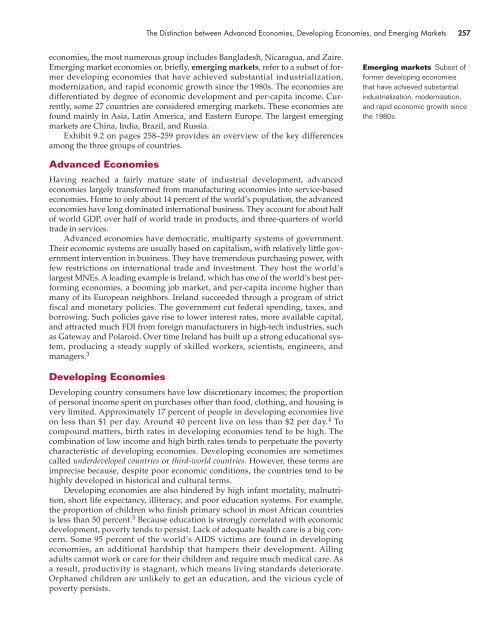Understanding Emerging Markets
Understanding Emerging Markets
Understanding Emerging Markets
Create successful ePaper yourself
Turn your PDF publications into a flip-book with our unique Google optimized e-Paper software.
CAVUMC09_254-283hr 10/15/07 11:23 AM Page 257<br />
The Distinction between Advanced Economies, Developing Economies, and <strong>Emerging</strong> <strong>Markets</strong> 257<br />
economies, the most numerous group includes Bangladesh, Nicaragua, and Zaire.<br />
<strong>Emerging</strong> market economies or, briefly, emerging markets, refer to a subset of former<br />
developing economies that have achieved substantial industrialization,<br />
modernization, and rapid economic growth since the 1980s. The economies are<br />
differentiated by degree of economic development and per-capita income. Currently,<br />
some 27 countries are considered emerging markets. These economies are<br />
found mainly in Asia, Latin America, and Eastern Europe. The largest emerging<br />
markets are China, India, Brazil, and Russia.<br />
Exhibit 9.2 on pages 258–259 provides an overview of the key differences<br />
among the three groups of countries.<br />
<strong>Emerging</strong> markets Subset of<br />
former developing economies<br />
that have achieved substantial<br />
industrialization, modernization,<br />
and rapid economic growth since<br />
the 1980s.<br />
Advanced Economies<br />
Having reached a fairly mature state of industrial development, advanced<br />
economies largely transformed from manufacturing economies into service-based<br />
economies. Home to only about 14 percent of the world’s population, the advanced<br />
economies have long dominated international business. They account for about half<br />
of world GDP, over half of world trade in products, and three-quarters of world<br />
trade in services.<br />
Advanced economies have democratic, multiparty systems of government.<br />
Their economic systems are usually based on capitalism, with relatively little government<br />
intervention in business. They have tremendous purchasing power, with<br />
few restrictions on international trade and investment. They host the world’s<br />
largest MNEs. A leading example is Ireland, which has one of the world’s best performing<br />
economies, a booming job market, and per-capita income higher than<br />
many of its European neighbors. Ireland succeeded through a program of strict<br />
fiscal and monetary policies. The government cut federal spending, taxes, and<br />
borrowing. Such policies gave rise to lower interest rates, more available capital,<br />
and attracted much FDI from foreign manufacturers in high-tech industries, such<br />
as Gateway and Polaroid. Over time Ireland has built up a strong educational system,<br />
producing a steady supply of skilled workers, scientists, engineers, and<br />
managers. 3<br />
Developing Economies<br />
Developing country consumers have low discretionary incomes; the proportion<br />
of personal income spent on purchases other than food, clothing, and housing is<br />
very limited. Approximately 17 percent of people in developing economies live<br />
on less than $1 per day. Around 40 percent live on less than $2 per day. 4 To<br />
compound matters, birth rates in developing economies tend to be high. The<br />
combination of low income and high birth rates tends to perpetuate the poverty<br />
characteristic of developing economies. Developing economies are sometimes<br />
called underdeveloped countries or third-world countries. However, these terms are<br />
imprecise because, despite poor economic conditions, the countries tend to be<br />
highly developed in historical and cultural terms.<br />
Developing economies are also hindered by high infant mortality, malnutrition,<br />
short life expectancy, illiteracy, and poor education systems. For example,<br />
the proportion of children who finish primary school in most African countries<br />
is less than 50 percent. 5 Because education is strongly correlated with economic<br />
development, poverty tends to persist. Lack of adequate health care is a big concern.<br />
Some 95 percent of the world’s AIDS victims are found in developing<br />
economies, an additional hardship that hampers their development. Ailing<br />
adults cannot work or care for their children and require much medical care. As<br />
a result, productivity is stagnant, which means living standards deteriorate.<br />
Orphaned children are unlikely to get an education, and the vicious cycle of<br />
poverty persists.

















